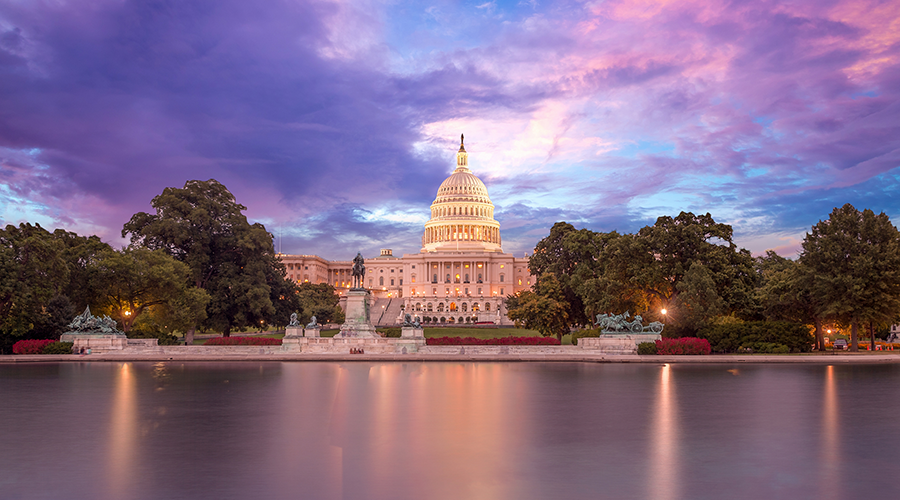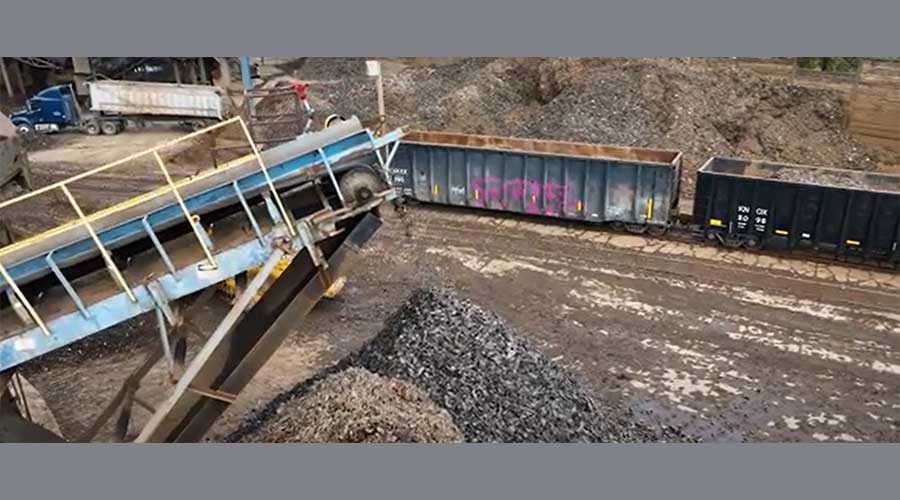Stay updated on news, articles and information for the rail industry
2/12/2024
Rail News: Federal Legislation & Regulation
A year after East Palestine, safety remains the No. 1 rail topic in Congress, insiders say

By Julie Sneider, Senior Editor
When railroaders and industry stakeholders return to Capitol Hill on May 8 for the annual Railroad Day on the Hill, most expect lawmakers will want to talk about East Palestine.
Since a Norfolk Southern Railway train carrying hazardous materials derailed a year ago in the small Ohio community near the Pennsylvania border — causing no injuries or fatalities, but a lot of property damage and local panic — several members of Congress have jumped on the rail safety bandwagon. The derailed train spilled toxic chemical materials, caused a subsequent fire and required rail cars containing vinyl chloride to be burned/vented — resulting in ominous black smoke clouds that hovered over the community and prompting residents to worry about the accident’s impact on the environment, public health and their overall wellbeing.
Congressional members declared the need for more regulations aimed at preventing another rail disaster, or "bomb train" — as some in the media have hyperbolized hazmat trains — from happening again.
In the weeks after the Feb. 3, 2023, derailment, Ohio’s two U.S. senators — Sherrod Brown (D) and J.D. Vance (R) — introduced the Railway Safety Act (S. 576), which would increase safety protocols for railroads and add provisions for trains carrying hazardous materials. The bill proposes to add new requirements for wayside defect detectors; mandate a minimum of two-person train crews on most freight trains; and impose higher fines for rail safety violations.
In May 2023, the U.S. Senate Committee on Commerce, Science and Transportation voted to advance the bill to the Senate floor. Although Senate Majority Leader Chuck Schumer (D-N.Y.) is seeking a vote on the bill in 2024, he had yet to schedule one as of press time.
Meanwhile, House Transportation and Infrastructure Committee Chair Sam Graves (R-Mo.) reportedly has indicated he’ll wait for the National Transportation Safety Board’s final report and recommendations on the derailment before taking up any proposed legislation. In a preliminary report, NTSB members said the investigation would focus on the role that wheel bearings and wayside defect detectors may have had in the derailment’s cause. Last month, NTSB Chair Jennifer Homendy told a House panel that she expects the board’s findings and recommendations to be released in late spring or early summer.
At the same time, U.S. Transportation Secretary Pete Buttigieg and Federal Railroad Administration leaders have called on the freight-rail industry to improve safety, including accountability for accidents and derailments. Since East Palestine occurred, Buttigieg said he wants the industry to speed up the phase-in of safer tank cars, known as DOT 117s. He also called on Class Is to join the FRA’s Confidential Close Call Reporting System that allows rail workers to anonymously report unsafe conditions without fear of punishment by their employers. Last month, NS became the first Class I to join a pilot version of the program.
Moreover, Buttigieg asked railroads to provide their workers paid sick leave (which many have since done), and suggested Congress should increase the maximum fines USDOT can issue to railroads for violating safety regulations. Plus, the FRA is considering a final rule that could mandate two-person crews on certain types of trains.
In an interview with CNN in mid-January, Buttigieg pointed at the rail industry when asked why the Railway Safety Act is stalled in Congress.
"The railroad industry lobby famously has had a lot of power," Buttigieg said. "In the last administration, they helped weaken some rail safety regulations. They’ve resisted some of the safety regulations that we at the Department of Transportation are continuing to advance. ... [The Railway Safety Act] has bipartisan support. I think the vast majority of Americans believe this ought to be done."
Concerns remain over Safety Act

Suffice it to say, the railroads have a lot more lobbying to do in D.C. this year — and a lot more collaborating to find common ground.
For its part, the Association of American Railroads has said it’s willing to work with members of Congress and the Biden administration to improve railroad safety if the proposals are rooted in scientific research and data — not on ideology, politics or anecdotes. Case in point: Regarding the FRA’s proposed two-person train crew rule, AAR President and CEO Ian Jefferies on Jan. 18 told the House Subcommittee on Railroads, Pipelines and Hazardous Materials that there’s no proof the measure would make freight-rail operations safer than they are now.
"We don’t believe there is objective data to support this rule," Jefferies told the committee members while FRA Administrator Amit Bose sat a few feet away at the witness table. "This [proposed rule] is a political gift made [to labor] on the campaign trail in 2020. That is a fact, and we’ll fight this rule hard."
The AAR remains open to supporting a rail safety bill, says AAR Senior Vice President of Government Affairs Adrian Arnakis.
"We have always been clear that we are willing for legislation to move forward and for there to be an agreement," she says. "And there was a lot of progress made as to where we started at the bill’s introduction and where it was in May, when the committee marked up the bill. That being said, there are areas of concern that we still think are really important to be addressed before the full Senate considers it."

AAR officials have said those provisions include "those that mandate crew staffing models, expand hazmat transportation operating requirements, micromanage detector networks and unnecessarily broaden manual inspections."
As of mid-January, it wasn’t clear if the legislation would garner enough support to pass for Schumer — who supports the legislation — to move the bill to the Senate floor for a vote, according to Arnakis. Once the NTSB comes out with its recommendations, support for a few safety provisions could come together "pretty quickly," she adds.
"The more you add onto legislation, the more it gets bogged down. And the more it gets bogged down, the less likely a bill gets voted on," says Arnakis. "I still think rail safety legislation getting passed is a coin flip, but I’m working and preparing for there to be legislation this year."
American Short Line and Regional Railroad Association (ASLRRA) members are concerned that the proposed Railway Safety Act doesn’t explicitly exempt short lines from regulations that would be daunting for them to implement, says ASLRRA President Chuck Baker.
"We are very focused on making sure that any bill that targets rail safety actually improves rail safety and doesn’t put mandates on short lines or on the industry that are so counterproductive they’re out of whack with safety benefits," he says.
Talking up CRISI grants

One key issue for short lines that Baker is looking forward to talking about on Capitol Hill is continued federal funding for the Consolidated Rail Infrastructure and Safety Improvements (CRISI) grant program. On Sept. 25, 2023, the FRA announced $1.4 billion in CRISI grants would be awarded to 70 projects as the fiscal-year 2022 recipients. Of those awards, 47 went to short-line projects — an unprecedented number. In addition, a record $720 million in funds were doled out to small railroad projects.
The grants are used to shore up short-line infrastructure, such as replacing worn-out track and ties and rehabilitating older bridges. Dollars also go toward projects that improve grade crossing safety, deploy safety technology and reduce emissions.
"We continue to be very excited about CRISI grants. They’ve become a huge deal," says Baker. "Short lines are stewards of infrastructure that typically needs a fair amount of investment help."
Typically, small railroads pay for a good portion of those projects out of their own pockets. But the good news out of the Infrastructure Investment and Jobs Act (IIJA) of 2021 was that it set a CRISI funding level at a minimum of $1 billion per year for each of fiscal years 2022 through 2026, Baker says. In addition, the IIJA also allows Congress to appropriate up to another $1 billion per year.
"So, we spend a lot of time and effort in D.C. focusing on trying to get that second tranche up as high as it can be. We had good success on that in FY22 and 23, with levels around $400 million to $500 million each," says Baker. "We are, and will be, spending a lot of time and effort focusing on those funding programs on Capitol Hill."
Another topic that Baker has been touting on the Hill: a potential program that would help short lines deal with the cost of rebuilding rail infrastructure damaged or destroyed by natural disasters. Currently, there’s no government program that helps small railroads recover after their lines are wiped out by a hurricane, for example.
In June 2023, U.S. Rep. Byron Donalds (R-Fla.) introduced the Short Line Railroad Relief Act (H.R. 3782), which would allow the federal government to grant funding for capital projects to protect, repair, reconstruct or replace short-line equipment and facilities damaged or destroyed by natural disasters. The bill has bipartisan support "and we’re going to do our best to turn that legislation into reality," Baker says.
Sticking up for passenger rail

Meanwhile, the passenger-rail industry has its own pressing agenda in D.C. Rail Passengers Association (RPA) President and CEO Jim Mathews believes much of RPA’s legislative agenda in 2024 will be focused on "defending" funding levels called for in the IIJA.
Although Congress passed the bipartisan legislation in 2021, a group of House Republicans in 2023 introduced an appropriations proposal that featured drastic cuts in funding for Amtrak, rail safety, infrastructure and high-speed rail. That bill would have set appropriations for the U.S. Department of Transportation and Department of Housing and Urban Development for fiscal-year 2024. And if passed, it would have cut Amtrak funding by 64% below the 2023 enacted level, reduced or potentially eliminate certain Amtrak long-distance and state-supported services, and risked operations and critical capital expenses on the Northeast Corridor, according to the Office of Management and Budget.
Although the proposal faced bipartisan blowback, Mathews believes that rail funding in the IIJA isn’t safe from future cuts proposed during the appropriations process — despite the fact that there are many Republicans in addition to Democrats who support Amtrak and other forms of rail service in their home districts.
The IIJA contained $66 billion in new funding for rail, including for Amtrak, plus authorization for additional funds through the appropriations process.
"If you had asked me a year ago, I would have said, 'Wouldn’t it be great to take the authorized amounts in the IIJA and add it to the appropriated amounts?' Remember, the $66 billion was only one part and then there was another $34 billion that was authorized for additional appropriations,” Mathew says. "But in the current environment, we’re defending that [$66 billion] number rather than hoping to add to it."
Mathews is disappointed with federal agencies' slow pace in distributing IIJA funds. For example, the FRA in late December 2023 issued the first round of IIJA-funded grants to expand intercity passenger-rail service. He’s concerned that sluggishness leaves money on the table that could be fought over in the next session of Congress.
Another effort RPA is tracking support for is the proposed "Freights First Act," a bill that U.S. Rep. Eric Burlison (R-Mo.) introduced last year to eliminate a federal provision that gives Amtrak trains the "right of preference" over freight trains on freight-owned track within 50 miles of a port or rail yard. Burlison has said the measure is necessary to eliminate train traffic bottlenecks and speed up the nation’s supply chain.
The Freights First Act is "nonsensical," Mathews says.
"It starts on the silly premise that Amtrak’s 300 trains a day across the country are single-handedly responsible for inflation by snarling the nation’s rail network and bringing it to a halt," he says. "But we are concerned about the bill. We’re making sure that key offices have factual arguments against this. And unlike Freights First Act proponents, we’re not using hyperbole to make our case."
Mathews agrees with those who say safety will be the top rail topic on lawmakers’ minds. Several industry stakeholders also believe the coming weeks and months will be an opportune time to talk about how rail transportation is a safe way to move people and freight.
"In 2024, the focus on rail safety will continue to be critical," says Ashley Wieland, president of the National Railroad Construction and Maintenance Association (NRC). "Rail safety bills continue to be at the top of mind for a number of members of Congress, and I think the industry will need a concerted effort to drive home the message that railroads are safe and are getting safer every year — despite the accident that happened."
The return of Railroad Day on the Hill in May will be a "great opportunity for all facets of the industry to come together and tell our story," Wieland adds.
Ashley Shelton, senior director of government and public affairs at the Railway Supply Institute (RSI), hopes to talk to lawmakers about the way her organization’s members tap into technology to improve rail safety. RSI members provide products and services for freight and passenger railroads.
"Our members are always innovating and trying to figure out new ways to be safer with whatever they’re making," Shelton says. "We believe that technology will make railroads safer, greener and more efficient, and we hope that the legislative environment and regulatory environment will be conducive to that continuing."
As Matt Ginsberg sees it, rail industry representatives will have to spend time on "perception repair" among some members of Congress.
"We thought 2023 would be kind of an easy year — just making relationships with new members of Congress. Then East Palestine happened," says Ginsberg, whose firm TGA Association Management Solutions represents the Railway Engineering-Maintenance Suppliers Association (REMSA) and NRC. "There’s this perception that rail is an unsafe industry and that there’s another accident that’s imminent — and of course we know that’s not the case. But I think collectively, the railroads and the rail supply industry need to continue educating key stakeholders and decision-makers. We have to let them know everything the industry is doing" to improve safety.
On that note, the AAR on Jan. 26 released a statement outlining the steps it says the industry has taken since the East Palestine derailment. Those steps include:
- increasing the frequency of hot bearing detectors (HBDs) across key routes. Class Is have purchased and installed hundreds of additional HBDs, with more to come online in 2024;
- establishing a new industry standard of stopping and inspecting trains when an HBD reading exceeds 170 degrees Fahrenheit;
- reviewing carriers’ current trending analysis programs to develop uniform recommendations for identifying bearings that may become problematic;
- training 20,000 first responders in local cities and towns and 2,000 at the Security and Emergency Response Training Center in Pueblo, Colorado;
- doubling the number of first responders with access to AskRail, which provides real-time information on rail-car content and safe handling of it;
- identifying recommendations for fire performance of tank cars and other service equipment; and
- continuing discussion with the FRA about joining its voluntary Confidential Close Call Reporting System.
More to discuss beyond safety
Although conversations about railroad safety will be the main priority, there are other policies and proposals that rail trade associations will be tracking this year, such as appropriations legislation; the potential for new environmental regulations of locomotive emissions; concerns over certain Buy America provisions; and Senate approval of nominations of individuals to serve on boards that affect railroading, including the National Mediation Board, National Transportation Safety Board, Railroad Retirement Board and Surface Transportation Board.
A perennial topic that all rail leaders will be on high alert for is any congressional attempt to increase federal limits on the length and weight of trucks that transport freight on the nation’s highways. The rail industry has long opposed trucking industry moves to convince Congress to allow heavier and longer trucks.
"We heard some rumblings that there was going to be some language about a pilot program that would increase truck size and weight limits, which we don’t want to see," says NRC’s Wieland. "We’ll continue to work with the industry and other advocacy groups to oppose any pilot program that would raise truck weight limits."
Whether a divided Congress can or will pass the Rail Safety Act, approve truck-size-and-weight increases or sign off on any legislative issue of interest to the rail industry remains to be seen in this presidential election year, rail association representatives say.
"It would be a huge uphill lift for this Congress to get done more than the bare minimum," says ASLRRA’s Baker. "I think a lot of people would consider it a success if we can keep the government functioning and funded."
Email questions or comments to julie.sneider@tradepress.com.
Contact Progressive Railroading editorial staff.


 2025 MOW Spending Report: Passenger-rail programs
2025 MOW Spending Report: Passenger-rail programs
 Gardner steps down as Amtrak CEO
Gardner steps down as Amtrak CEO
 Guest comment: Oliver Wyman’s David Hunt
Guest comment: Oliver Wyman’s David Hunt
 Women of Influence in Rail eBook
Women of Influence in Rail eBook
 railPrime
railPrime







